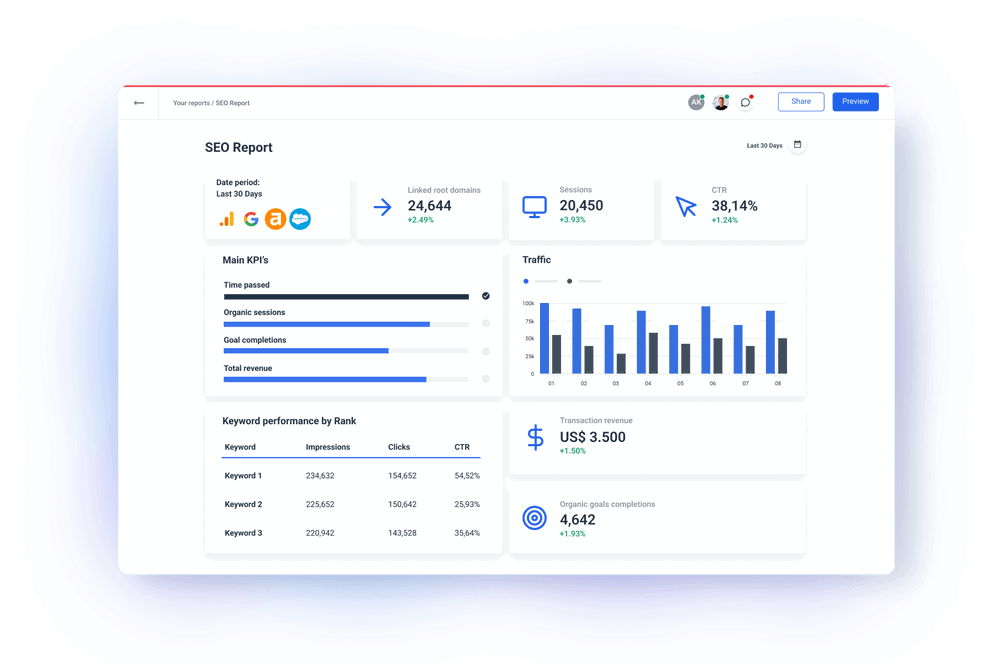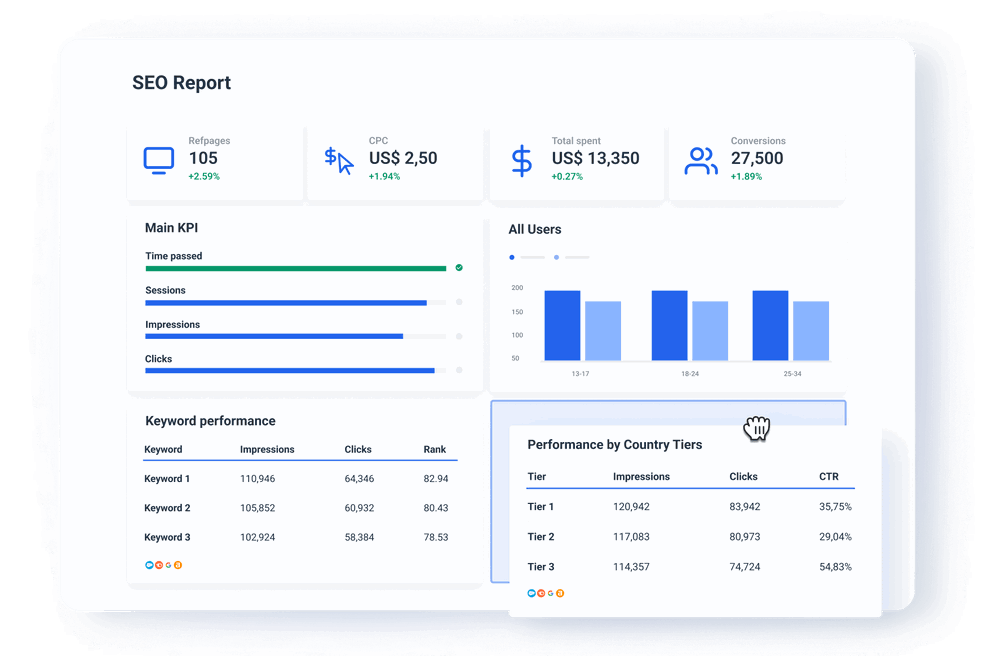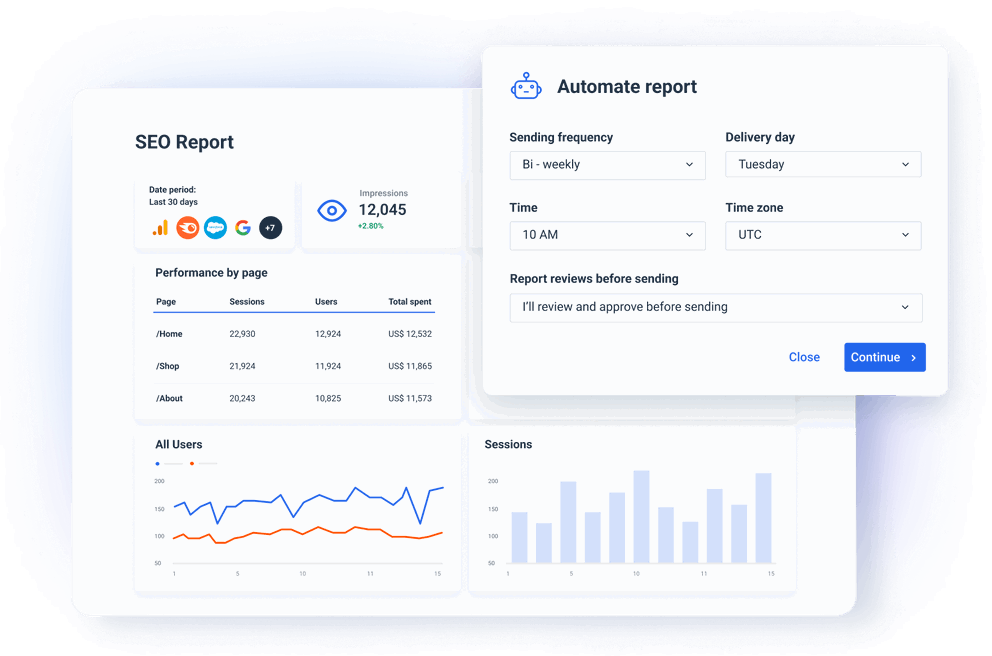What is an SEO report template?
An SEO performance report template is a ready-to-use report that helps you track, organize, and present key SEO performance from your SEO tools.
Instead of manually pulling data from different SEO tools, a good template lets you create a complete report in a matter of minutes.
No matter what type of SEO report you’re looking to create, the right SEO reporting template should help you:
✅ Improve your client relationships by proving ROI
✅ Highlight key performance indicators like traffic, rankings, and conversions
✅ Combine SEO data with insights from other platforms
✅ Customize the layout to match each client’s goals and branding
✅ Share the reports with clients via email, PDF, or a link
What should an SEO report include?
So, what should you actually include in your SEO reports? Here are the seven main things we recommend:
1. SEO KPIs progress
Purpose: Give a high-level overview of how your SEO efforts are tracking against goals.
Best practices:
✅ Show clearly whether the KPIs were reached or missed
✅ Focus on key metrics that matter to clients: organic traffic, conversions, clicks, backlinks, etc.
✅ Keep it visual and use progress bars and goal widgets
Widgets to use:
- Goal tracking widgets, comparison bars, single-value highlights
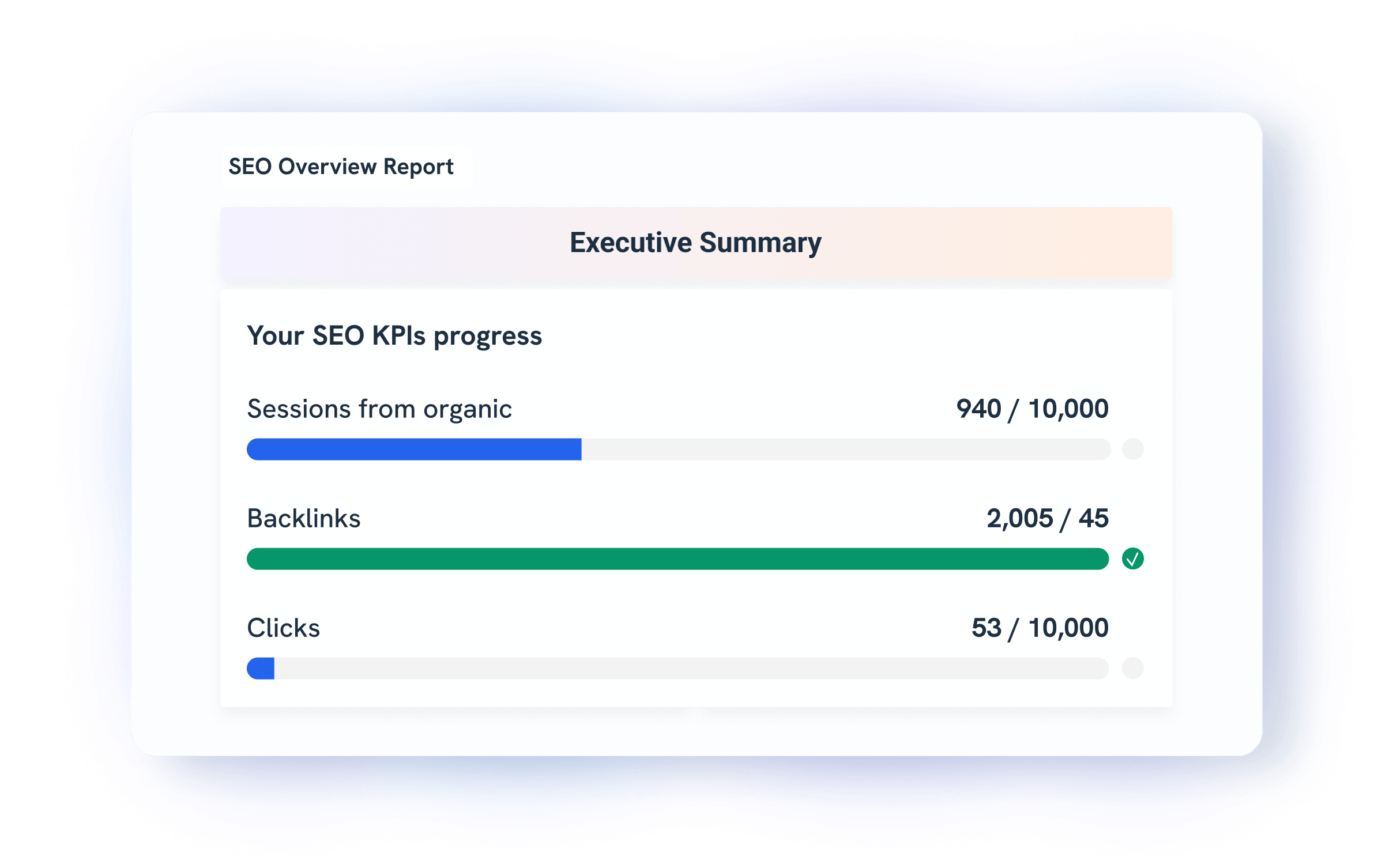
2. Individual KPI widgets
Purpose: Showcase specific SEO KPIs that your client cares most about.
Metrics to include:
- New users (number of new users from the SEO campaigns)
- Sessions (number of sessions from organic search)
- Backlinks (new backlinks generated)
- Impressions (how often your page appeared in search results)
- Conversions (completed goals, e.g., sign-ups or purchases)
- Click-through rate (percentage of users who clicked on your page after seeing it)
Best practices:
✅ Prioritize metrics that tie into business goals (for example, not just impressions, but also sessions or new users)
✅ Stick to 3-5 key metrics for readability
✅ Keep it consistent month to month
Widgets to use:
- Single-value widgets, comparisons, and goal progress bars
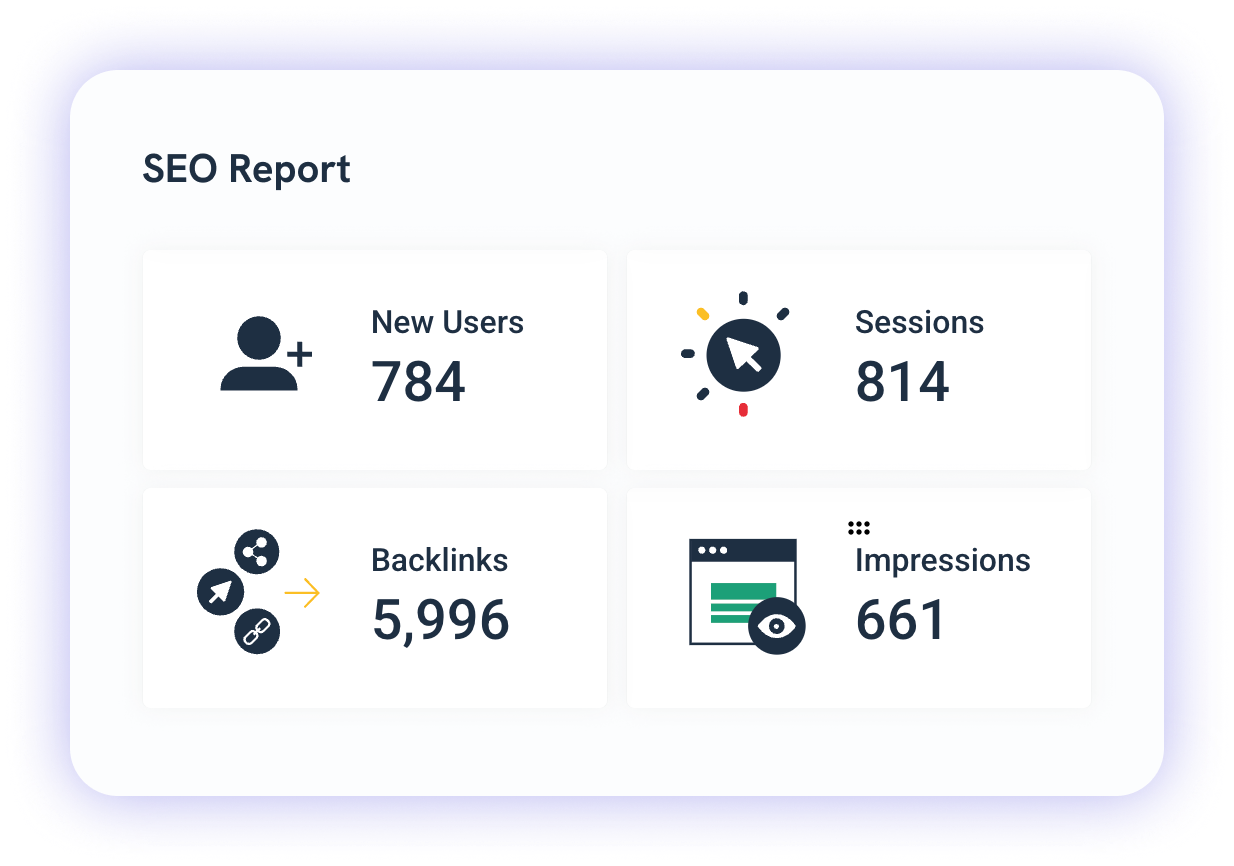
3. SEO performance summary
Purpose: Explain what happened during the reporting period and what it means.
Best practices:
✅ Highlight major changes—traffic drops, lost links, ranking gains, etc.
✅ Use AI to create performance summaries on your behalf based on your data for a specific time period
✅ List the next steps for improving results
Widgets to use:
- Text block widget: Add an AI-generated performance summary or write your own
- Image or GIF: For an additional context, you can add an image or GIF
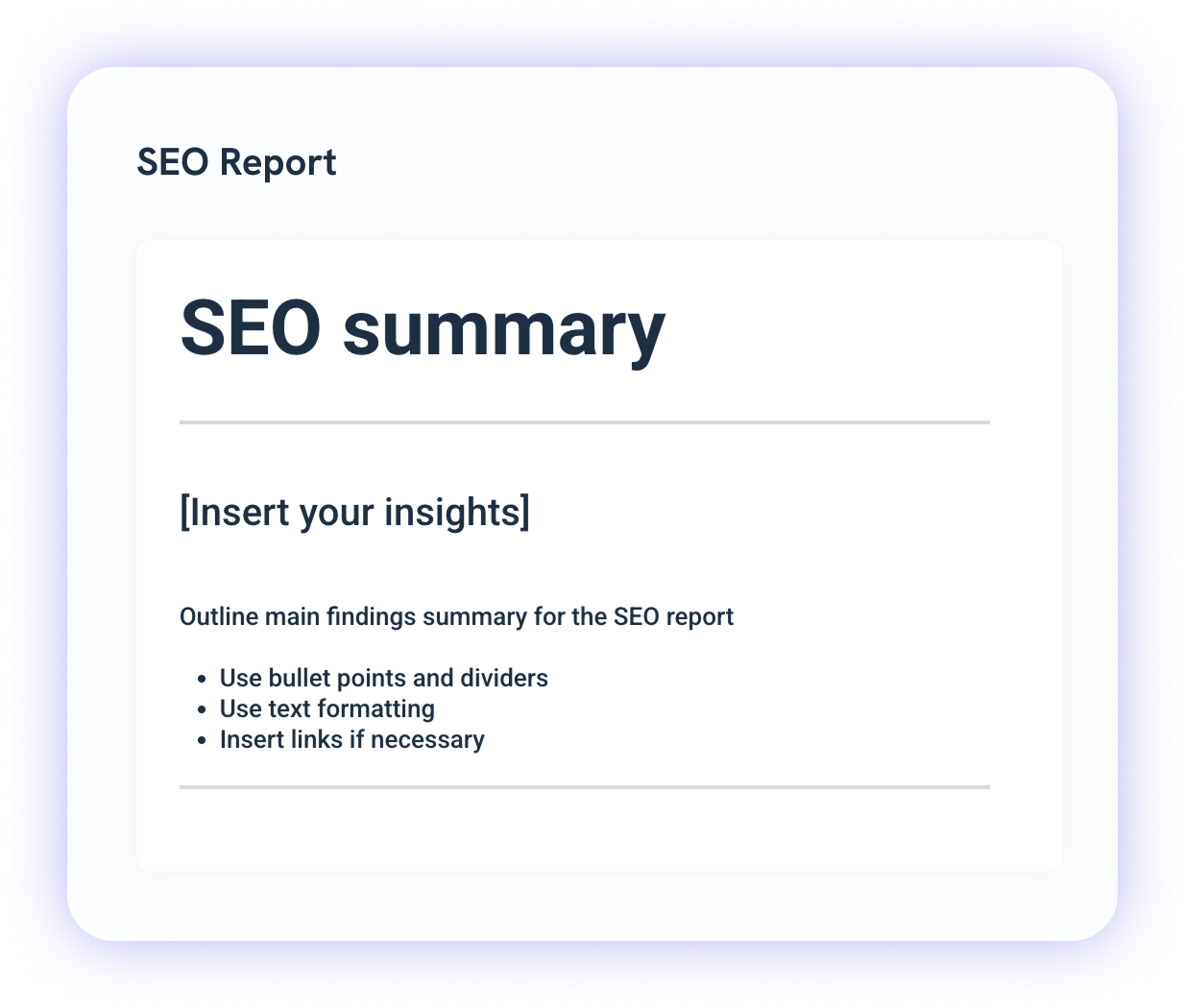
4. Organic traffic trend chart
Purpose: Show the organic traffic trend chart, so clients understand how traffic has evolved over time.
Best practices:
✅ Show data from the previous month (or more, like 2-6 months)
✅ Use line charts to illustrate how the traffic has changed
✅ Add more context to sudden traffic spikes with comments
Widgets to use:
- Single-value widgets, funnels, vertical bars, and line charts
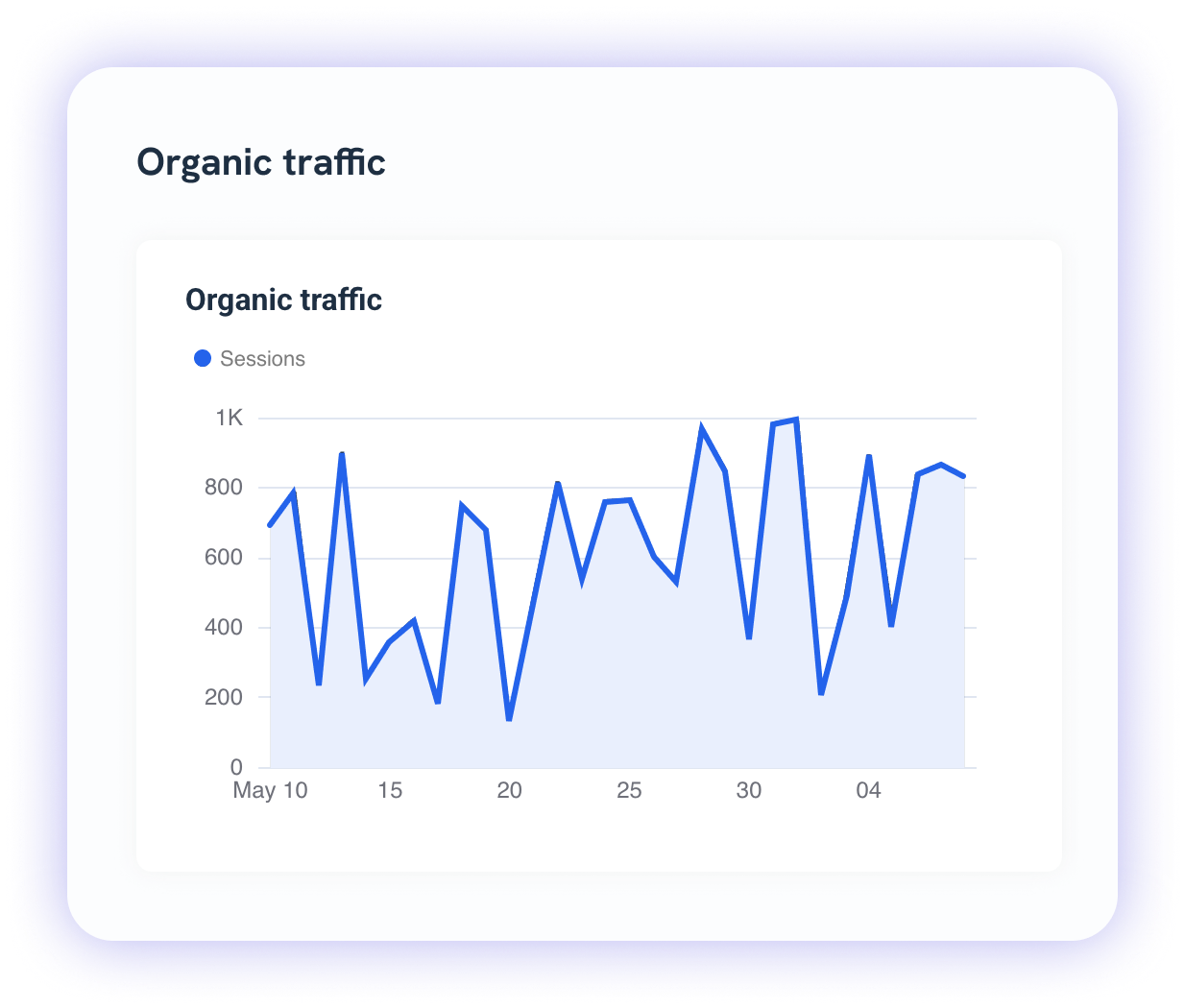
5. Organic search traffic funnel
Purpose: Compare organic sessions against goal completions and new revenue to show the real business impact.
Best practices:
✅ Make a graph comparing organic sessions vs total sessions
✅ Map the funnel: sessions → users → goal completions all
✅ Pull data from Google Analytics 4 and other platforms to complement the SEO data
Widgets to use:
- Multi-line graph: Comparing organic sessions vs. % new sessions
- Single-value widget: To display key metrics and the average position across all keywords

6. List of keyword rankings
Purpose: Give a granular view of keyword performance, so clients know if they’re ranking for the right search terms.
Best practices:
✅ Highlight keywords by clicks, CTR, average rank, etc.
✅ Break down keyword performance by web research and rankings
✅ Give the option to sort by ascending or descending clicks
Widgets to use:
- Table widget with filters (keyword, impressions, clicks, CTR, etc.), visual trend lines
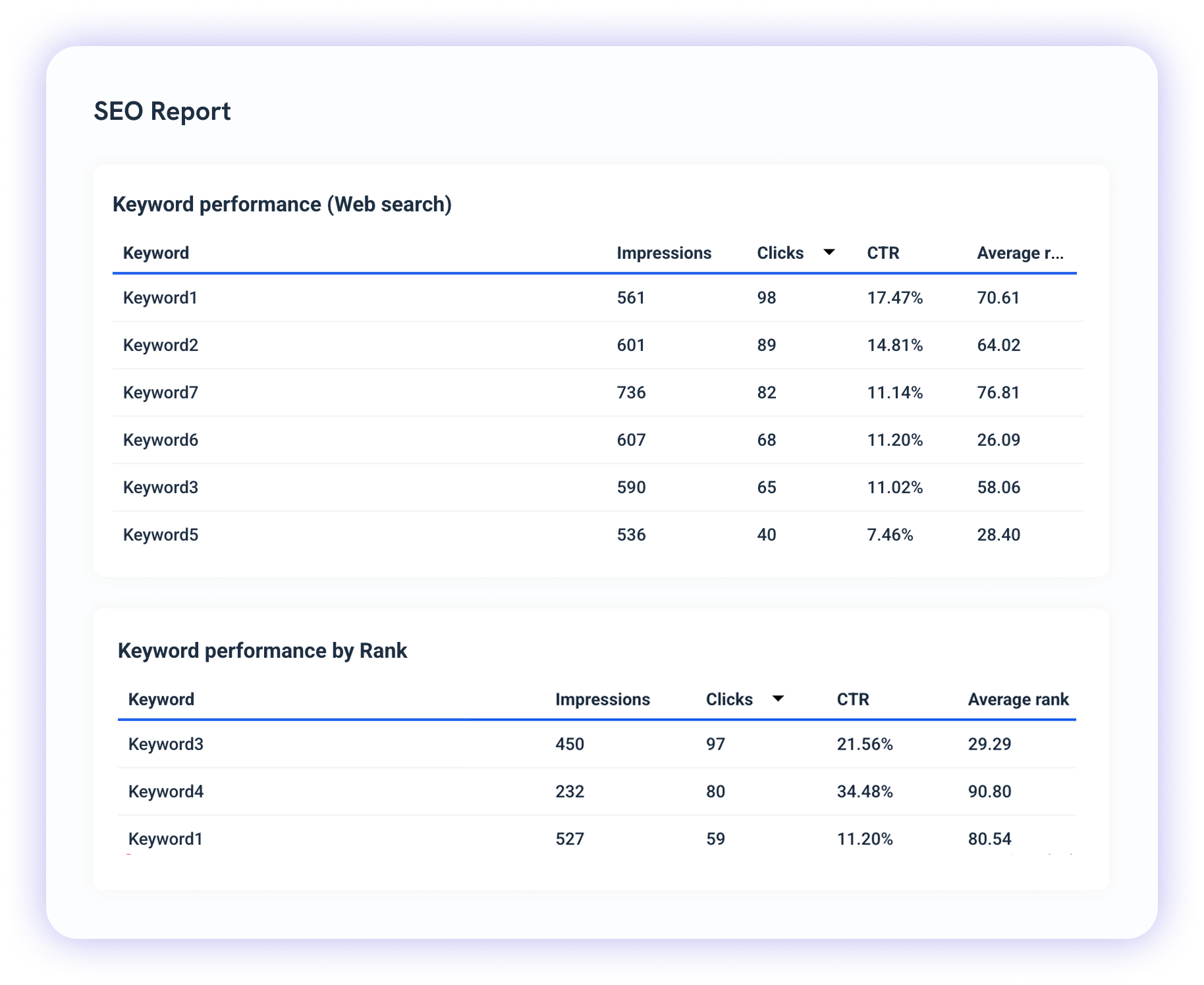
7. Number of backlinks built
Purpose: Show the number of backlinks built—an important part of off-page SEO.
Best practices:
✅ Show total backlinks, new links acquired, referring domains, and domain authority
✅ List the pages from which the backlinks are acquired
✅ Explain how the positions changed
Widgets to use:
- Single value widget, text blocks, and goal widgets

How do I create an SEO report using a template?
Instead of manually pulling data from multiple tools, the easiest way to create an SEO report is to use a dedicated SEO reporting tool, like Whatagraph.
With Whatagraph, you can create a report in five simple steps:
1. Add SEO tool as a source
To begin, you need to connect your SEO tool through our plug-and-play integration.
From Whatagraph’s dashboard, you can simply choose your preferred SEO tool as your source.
We integrate with all the main SEO tools, including:
- Ahrefs
- Semrush
- SE Ranking
- SEOMonitor
- Google Search Console
- Google My Business
- AccuRanker
The good thing is, there is no limit on how many SEO tools you can integrate. If you use all of the above, you can pull data from all of them into one unified report.
Plus, Whatagraph integrates with different social media, analytics, email marketing, and ecommerce platforms for cross-channel insights.
2. Organize your data
Every SEO tool reports data differently, and if you’re used to building reports manually with tools like Google Sheets, you know the process can get messy.
The best SEO reporting tools solve this by letting you structure everything in one unified view.
For example, with Whatagraph, you can:
- Group data from multiple campaigns into regions or tiers
- Blend data sources, like SEO and paid ads, into a unified metric
- Create custom metrics that show, for example, clicks from multiple keywords
- Apply tags and folders to organize by client, region, or Account Manager
- Standardize naming across campaigns
This step is important to make your SEO marketing report clear and easy to understand.
3. Select a dashboard template
Templates can either make or break your reports. And unfortunately, not all SEO report example templates are created equal.
On Whatagraph, we offer 55+ pre-made reports and dashboard templates, including our professional SEO report dashboard template.
All the templates come pre-loaded with the most important KPIs.
For each report, you have full control of how you want it to look. You can:
✅ Select from pre-made color schemes or create your own
✅ Pick different colors for graphs and charts
✅ Embed your own logos and custom messaging
✅ Add your own custom domain
✅ Personalize the cover page
✅ Use emojis and custom icons
After modifying the look, you can save the design and use it for as many reports as you need.
5. Use AI for performance summaries and insights
Want to explain campaign performance for clients? Doing this manually across multiple reports, for multiple clients, can take hours.
There is a better way: AI reporting tools, like Whatagraph.
With Whatagraph, you can add a text widget and use our AI to write a performance summary based on your data.
Select your preferred platform and a date range, and our AI will write a clear, editable paragraph you can add directly into your reports.
6. Share the dashboard with clients
Last but not least, it’s time to share your SEO report sample with clients or stakeholders.
Whatagraph offers many ways to do this:
- Email: Create white-labeled emails and schedule their sending. Want to send a daily SEO report or an annual SEO report? Fully customize your own intervals—the way you want.
- Link: Share a link and let clients look at SEO performance at their own pace.
- File: Create a PDF or CSV file and export the whole dashboard or parts of it.
Want to import your data into BigQuery or Looker Studio? Whatagraph gives you the tools for that.
What metrics are most important in an SEO report?
In general, here’s a breakdown of the key metrics you should include in your SEO performance report for clients:
Organic traffic:
The total number of sessions that came from organic searches without paid promotion. A good overall metric showing how well your SEO campaigns are bringing traffic.
Impressions:
The number of times your site showed up in search results. An increasing amount of impressions can signal better search visibility, even if clicks haven’t caught up yet.
Backlink profile:
A key SEO metric showing how many external websites link to your site. You should show both the total number of backlinks and the newly acquired ones from link building.
New users:
The number of first-time visitors from organic search. A helpful metric for understanding how well you’re attracting new visitors.
Organic transaction revenue:
Tracks new revenue from organic sessions. A key metric for connecting SEO to actual business outcomes.
Keyword performance:
Looks at metrics like clicks, impressions, and CTR, and measures how your target keywords are performing.
